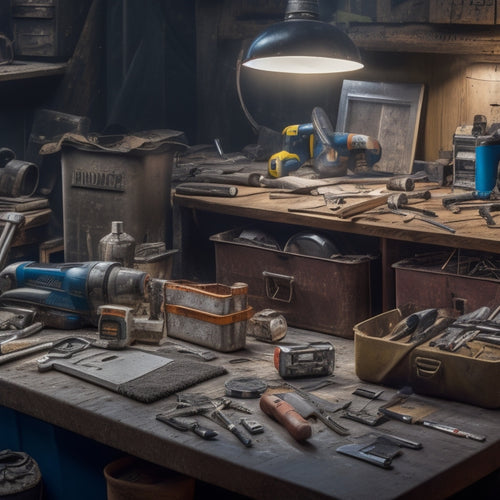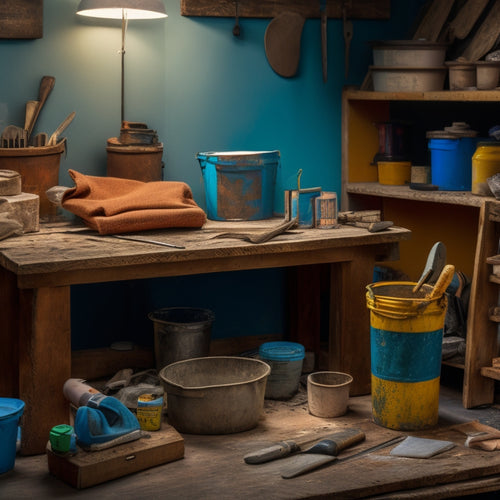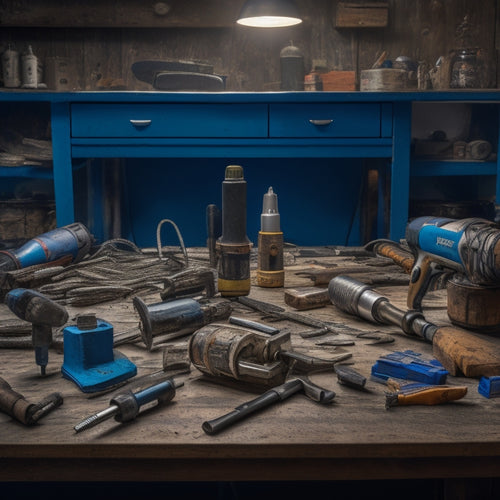
Protective Gear for Home Renovation Work
Share
When tackling home renovation work, you're surrounded by hazards that can cause serious injuries. To protect yourself, you'll need essential safety gear like long-sleeved shirts, safety glasses or goggles, and steel toe boots or shoes. Alkali-resistant gloves, respirators, and hard hats will also be vital in preventing skin and eye injuries, respiratory issues, and head trauma. Additionally, earplugs, full body harnesses, and fall protection equipment will safeguard your hearing and prevent falls. By understanding the risks and wearing the right gear, you'll guarantee a safe working environment - and taking the next step will provide even more insight into creating a thorough safety plan for your project.
Key Takeaways
• Wear long-sleeved shirts, long pants, and closed-toe shoes to minimize skin exposure to alkaline concrete dust and splashes.
• Safety glasses or goggles with anti-fog coatings and face shields protect eyes and face from debris and chemical splashes.
• Alkali-resistant gloves with padded palms and fingers provide hand protection from harsh chemicals and heavy objects.
• Steel toe boots and shoes with slip-resistant soles prevent foot injuries from heavy objects and falls on various surfaces.
• Hard hats and helmets with electrical resistance protect the head from impacts, falling debris, and electrical shock.
Essential Safety Gear for Concrete
When working with concrete, you must wear protective gear to prevent skin and eye injuries from alkaline concrete dust, splashes, and spills. This is especially vital during concrete curing and mixing techniques, where the risk of exposure is highest.
A sturdy pair of gloves, preferably made from alkali-resistant materials, will protect your hands from harsh chemicals. Safety glasses or goggles with a good seal will shield your eyes from splashes and dust. A dust mask or respirator will prevent inhalation of concrete particles, which can cause respiratory issues.
In addition to these essentials, consider wearing long-sleeved shirts, long pants, and closed-toe shoes to prevent skin exposure. A hat and hair cover will keep hair clean and out of your face.
When mixing concrete, use a mixing stick or trowel to minimize direct contact. Always follow the manufacturer's instructions for concrete curing compounds and mixing techniques to guarantee a safe and successful project.
Protection From Falling Debris
When you're working on a home renovation, you'll need to take measures to prevent falling debris from causing injuries or damage.
You'll want to guarantee that you have the right gear to contain and deflect falling objects, and that you're wearing the proper head protection to shield yourself from impact.
Debris Netting and Tarps
You'll need to install debris netting and tarps around your renovation site to prevent falling objects from causing damage or harm to people and property. This vital step in debris management guarantees that your site remains safe and organized. Debris netting, a mesh material, captures falling debris, while tarps provide an extra layer of protection by covering surfaces and preventing damage from water or other elements.
| Debris Netting and Tarp Installation Tips | Benefits |
|---|---|
| Install debris netting around scaffolding and overhead work areas | Prevents falling objects from causing harm or damage |
| Securely fasten tarps to surfaces to prevent wind uplift | Protects surfaces from water and debris damage |
| Regularly inspect and maintain debris netting and tarps | Guarantees continued effectiveness and safety |
Hard Hats and Helmets
Your hard hat or helmet is the single most critical piece of protective gear for safeguarding your head from falling debris, making it an essential component of your personal protective equipment (PPE) on the renovation site.
When selecting a hard hat, consider factors such as impact resistance, penetration resistance, and durability. Look for helmets that meet rigorous helmet standards, such as those set by the American National Standards Institute (ANSI) or the Occupational Safety and Health Administration (OSHA).
A hard hat selection that meets these standards will guarantee your head is protected from falling objects, including tools, materials, and debris.
Additionally, consider the type of renovation work you'll be doing and choose a hard hat that's specifically designed for that task. For example, if you'll be working with electrical systems, choose a hard hat with electrical insulation.
Always inspect your hard hat regularly for signs of damage or wear, and replace it if necessary.
Securing Loose Materials
Unsecured materials and debris on scaffolding, roofs, or upper levels can become deadly projectiles, making it crucial to implement measures that prevent them from falling and causing harm.
You must guarantee that all materials are properly secured to prevent them from becoming airborne and striking you or others on site. To achieve this, prioritize material storage and site organization. Confirm that materials are stored in a designated area, away from walkways and working zones.
Use netting, tarps, or other coverings to contain loose materials, and secure them with ropes or straps. Additionally, establish a 'clean as you go' policy to prevent debris from accumulating. Regularly inspect your site to identify potential hazards and take corrective action.
Eye and Face Shields
Wearing eye and face shields during home renovation projects is essential to prevent debris, dust, and chemical splashes from causing serious eye injuries and facial lacerations. You must prioritize your safety and invest in quality protective gear to minimize the risk of accidents.
When selecting an eye and face shield, consider the following key factors:
-
Lens options: Choose between polycarbonate, acetate, or Trivex lenses, each offering varying levels of impact resistance, optical clarity, and weight.
-
Face fit: Make sure the shield fits snugly around your face, with adjustable straps and a comfortable, padded frame to prevent slipping and fogging.
-
Anti-fog coating: Opt for shields with an anti-fog coating to maintain clear visibility in humid environments.
- Certifications: Look for shields meeting ANSI Z87.1+ or CSA Z94.3 standards, guaranteeing compliance with industry safety regulations.
Respiratory Masks and Filters
In addition to protecting your eyes and face, you'll need to safeguard your respiratory system from airborne contaminants and hazardous particles that can cause serious health issues during home renovation projects. Respiratory masks and filters are essential for maintaining good respiratory health, especially when working with materials that emit toxic fumes or generate dust.
| Filter Type | Protection Level |
|---|---|
| N95 | 95% of airborne particles |
| N100 | 99.97% of airborne particles |
| Half-Face Respirator | Protection against gases, vapors, and particles |
| Full-Face Respirator | Total respiratory protection, including eyes |
| HEPA Filter | 99.97% of particles as small as 0.3 microns |
When choosing a respiratory mask or filter, consider the specific hazards present in your work environment. For example, if you're working with asbestos or lead, you'll need a filter with a higher protection level. Always follow the manufacturer's instructions for proper use and maintenance to guarantee your respiratory health is protected. Remember, it's always better to err on the side of caution when it comes to your health.
Gloves for Hand Protection
When handling hazardous materials or performing tasks that involve sharp edges, abrasive surfaces, or heavy objects, you'll need gloves that provide adequate hand protection to prevent cuts, abrasions, and crushing injuries during home renovation projects. The right gloves can make all the difference in guaranteeing your safety and comfort while working.
Here are some essential features to look for in gloves for hand protection:
-
Latex gloves for chemical resistance and protection against corrosive substances.
-
Padded gloves for cushioning and shock absorption when handling heavy objects or power tools.
-
Cut-resistant materials, such as Kevlar or Dyneema, to prevent lacerations and abrasions.
- Reinforced palms and fingers for added durability and grip.
When choosing gloves, consider the specific tasks you'll be performing and the hazards you'll be exposed to.
Select gloves that provide a snug fit, flexibility, and dexterity to guarantee you can work efficiently and safely.
Steel Toe Boots and Shoes
When you're working on a home renovation project, you need footwear that can keep up with the demands of the job.
You'll want to choose steel toe boots or shoes that offer reliable toe protection features, such as impact-resistant materials and secure toe caps.
Toe Protection Features
You need steel toe boots or shoes with excellent toe protection features to safeguard your toes from heavy objects, sharp edges, and crushing injuries during home renovation projects.
The anatomy of your toes is complex, with 26 bones, 33 joints, and over 100 muscles, tendons, and ligaments working together to provide support and movement. With so many delicate structures, it's essential to provide adequate protection to prevent injuries.
When choosing steel toe boots or shoes, look for features that meet or exceed safety standards. Here are some key features to take into account:
-
Toe cap material: Steel, aluminum, or composite materials provide excellent impact resistance.
-
Toe cap design: A sturdy, rounded design helps to distribute force away from your toes.
-
Impact resistance: Look for boots or shoes that can withstand a minimum of 75 pounds of impact force.
- Crush resistance: Verify your boots or shoes can resist a minimum of 2,500 pounds of crush force.
Comfort and Durability
Comfort and Durability
With steel toe boots and shoes, you require a delicate balance between protection and comfort, as inadequate comfort can hinder your performance and increase fatigue during extended home renovation projects. You need footwear that not only safeguards your toes but also provides ideal comfort and durability.
When selecting steel toe boots and shoes, consider the following key factors:
| Feature | Benefit |
|---|---|
| Breathable fabrics | Enhances airflow, reducing sweat and blisters |
| Lightweight materials | Minimizes fatigue, allowing you to work longer |
| Cushioned insoles | Absorbs shock, reducing discomfort and strain |
Hard Hats and Helmets
During home renovation projects, falling debris and tools can strike workers, making hard hats and helmets essential protective gear to prevent head injuries.
As you work on your project, you need to guarantee you're wearing a hard hat or helmet that meets the required safety standards. Familiarize yourself with hard hat regulations, which vary depending on the country or region you're in.
When choosing a hard hat or helmet, consider the following factors:
-
Impact resistance: Look for helmets that can withstand impact from falling objects.
-
Penetration resistance: Confirm your helmet can protect you from sharp objects piercing through.
-
Electrical resistance: If you're working with electrical systems, choose a helmet with electrical resistance to prevent shock.
- Comfort and fit: Select a helmet that fits snugly and comfortably to prevent it from shifting during work.
Earplugs and Earmuffs
Exposure to loud noises from power tools, machinery, and demolition can cause permanent hearing damage, making earplugs and earmuffs vital protective gear for home renovation projects. You don't want to risk noise-induced hearing loss (NIHL), which can occur when sound levels exceed 85 decibels. As you work on your renovation, you'll likely be exposed to loud noises from drills, saws, and hammers, so it's important to take preventative measures.
Earplugs and earmuffs are designed to reduce noise levels, providing acoustic insulation that safeguards your hearing. There are different types of earplugs and earmuffs available, including disposable foam earplugs, custom-made earplugs, and earmuffs with noise-cancelling technology.
When choosing the right ear protection for your project, consider the noise level of your tools and the duration of your work. Make sure to fit your earplugs or earmuffs correctly to guarantee the best protection.
Don't take your hearing for granted – invest in quality ear protection to prevent permanent damage and make sure you can enjoy the fruits of your labor for years to come.
Full Body Harnesses
As you ascend ladders, scaffolding, or roofs, a full body harness becomes an essential piece of protective gear to prevent falls and maintain your safety during home renovation projects. A full body harness is designed to distribute the force of a fall across your body, reducing the risk of injury or fatality. When choosing a harness, it's vital to select the right type for your specific task.
Here are some key considerations for selecting and maintaining your full body harness:
-
Harness types: Choose from sit harnesses, full body harnesses, or climbing harnesses, depending on the activity and level of risk involved.
-
Proper fitting: Guarantee a snug, comfortable fit, with adjustable straps and leg loops to accommodate your body type.
-
Regular inspection: Inspect your harness regularly for signs of wear, damage, or degradation, and replace it if necessary.
- Proper use: Always follow the manufacturer's instructions for use, and guarantee you're properly connected to a secure anchor point.
Frequently Asked Questions
Can I Wear Contact Lenses With Safety Goggles?
When you wear contact lenses with safety goggles, compatibility is key.
You need to verify the goggle design won't dislodge your lenses or obstruct your vision.
Look for goggles with a soft, cushioned seal that won't put pressure on your eyes.
Additionally, choose goggles with anti-fog coatings to prevent moisture buildup.
With the right combination, you can enjoy contact lens safety and goggle compatibility, allowing you to focus on the task at hand.
How Often Should I Replace My Respirator Filters?
You're maneuvering through a dust storm of DIY projects, and your respirator is your shield.
When it comes to filter maintenance, you can't be too careful. Replace your respirator filters every 1-3 months, depending on usage and exposure to airborne contaminants.
Don't gamble with respiratory safety - inspect filters regularly, and swap them out if they're damaged, dirty, or expired.
Stay vigilant, and breathe easy knowing you're protected.
Are Steel Toe Boots Suitable for Outdoor Construction Sites?
When you're working on outdoor construction sites, you need footwear that can keep up.
Steel toe boots are a great choice, offering excellent protection against heavy objects and sharp edges. The steel toe benefits extend beyond just toe protection, providing stability and support on uneven terrain.
For outdoor safety, look for boots with slip-resistant soles and waterproofing to keep your feet dry and secure.
With the right pair, you'll be able to tackle any outdoor construction project with confidence.
Can I Use Ordinary Earbuds as Ear Protection?
Can you really afford to gamble with your hearing?
Ordinary earbuds won't cut it as ear protection - they're designed for music, not safeguarding your ears from hazardous noise exposure. Their effectiveness is severely limited, leaving you vulnerable to permanent damage.
When you're surrounded by power tools and construction chaos, you need specialized gear that can withstand the acoustic onslaught.
Don't risk irreversible harm; invest in certified ear protection that's battle-tested for your safety.
Do Hard Hats Expire After a Certain Period of Time?
You're wondering if your hard hat has an expiration date. The answer is yes, it does.
Hard hats have a limited lifespan, typically ranging from 2 to 5 years, depending on the manufacturer's guidelines.
Proper hard hat maintenance is essential to guarantee its effectiveness. Regularly inspect your hard hat for signs of wear, and replace it if you notice any damage or degradation.
Don't compromise on safety - stay informed about the lifespan of your safety equipment to avoid risks.
Conclusion
You've made it to the final stage of preparing for your home renovation project.
Remember, safety always comes first.
Don't compromise on protective gear, or you might end up like John, who suffered a serious head injury from a falling beam because he didn't wear a hard hat.
Invest in the essential safety gear outlined above, and you'll be well on your way to a successful and injury-free renovation project.
Stay safe!
Related Posts
-

Smart Guide to Buying Second-Hand Renovation Tools
When buying second-hand renovation tools, you'll want to set clear renovation goals and a realistic budget to priorit...
-

DIY Plastering Supply Checklist for Home Renovation
To tackle a DIY plastering project for your home renovation, you'll need a solid checklist of supplies. Start with es...
-

What to Look for in Pneumatic Renovation Tools
When selecting pneumatic renovation tools, you'll want to take into account several key factors to guarantee optimal ...


